Addressing the Nation's Urgent Needs: Can Electric Car Owners Utilize Their Vehicles at Zero Cost?
![]() 07/10 2025
07/10 2025
![]() 549
549
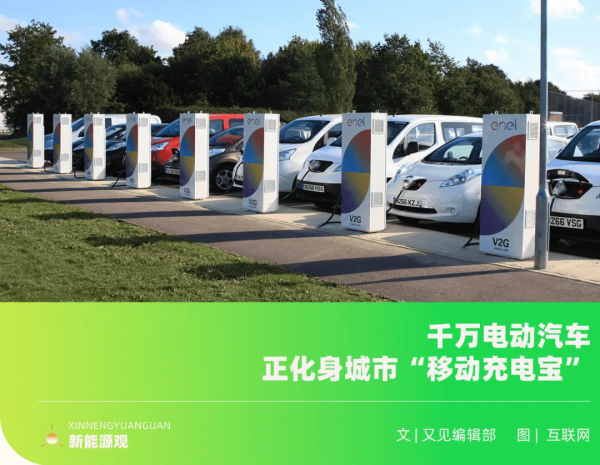
Original by New Energy View (ID: xinnengyuanqianzhan)
Full text: 2982 words, reading time: 10 minutes
On July 4, at noon, Wuhan's temperature soared to 39°C. Amid the hum of air conditioners, the Wuhan power grid's load surged to 17.048 million kilowatts, a 26.48% increase year-on-year, setting this year's first peak load—20 days earlier than the previous year. The same day, the national grid load hit a record high of 1.465 billion kilowatts, with grids in Jiangsu, Anhui, Shandong, and other provinces consecutively "hitting the limit."
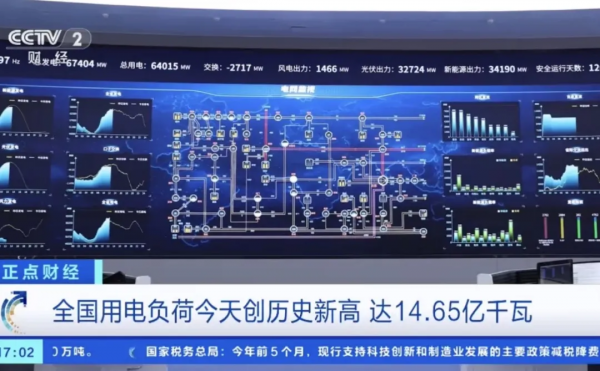
Image/National electricity load hits a record high this summer
Source/Screenshot from New Energy View
Despite investing 30.3 billion yuan to commission 140 summer projects, the State Grid struggled to withstand the intense heat. In Jiangsu, 90% of the grid's load increase was attributed to air conditioning. As soon as the air conditioner turned on, the electricity meter spun rapidly. While grid dispatchers sweated profusely in substations, in the Chengdu Shuangliu Telaidian Charging Station, Zhu Liang (pseudonym), a new energy vehicle owner, tapped his phone screen, and his car began to feed electricity back into the 10kV grid: he earned tens of yuan in an hour of downtime.
This scenario is transitioning from the laboratory to the streets—vehicle-to-grid (V2G) technology transforms electric vehicles into "grid power banks," opening up a profitable opportunity amidst the scorching heat.
1. Overcoming the "V2G Interaction" Dilemma Amid Tight Power Constraints
This summer's grid is like a taut string, with a wave of high-temperature warnings coloring half of the country on the weather forecast map.
In Bozhou, Anhui, residential electricity consumption accounts for over 65%, and the concentrated use of air conditioners leads to a significant peak-to-valley difference with few adjustable loads. In Wanzhou, Chongqing, the maximum grid load increased by 4.75% year-on-year. In Xi'an, Shaanxi, the grid predicts that this summer's load will reach 14.8 million kilowatts, with an average annual growth rate of basic load as high as 7%...
Traditional measures are stretched thin. The State Grid has done its utmost, commissioning 140 projects to increase power supply capacity by over 30 million kilowatts, but in the face of load growth often reaching hundreds of millions of kilowatts, new solutions are imperative.
Against this backdrop, V2G technology has arrived at the right time. Electric vehicles have become the "dream car" of the State Grid this summer.
Under the blazing sun, Chengdu car owner Zhu Liang scanned a code to initiate V2G discharge, with current flowing back into the 10kV public grid. "The operation is as simple as charging, just plug in and scan the code," he said, earning 48 yuan while eating—equivalent to selling 80% of the battery's capacity (48 kWh) at 1 yuan/kWh, netting over 30 yuan after deducting night off-peak charging costs.
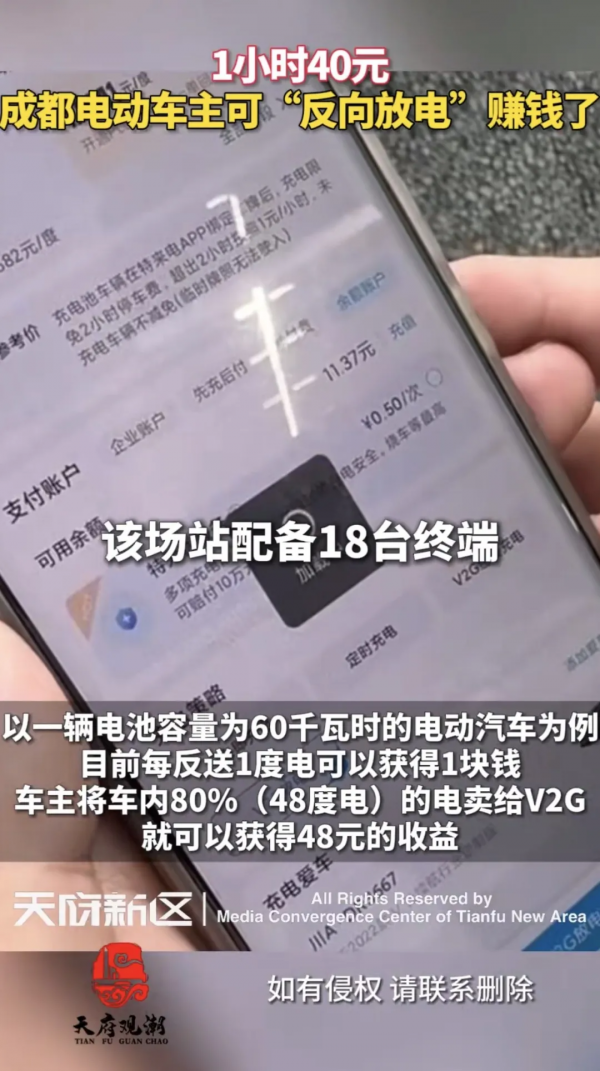
Image/Chengdu car owner performing V2G discharge operation
Source/Screenshot from New Energy View
So-called V2G interaction primarily includes smart ordered charging and reverse discharge (V2G). Through energy interaction modes, it enables bidirectional energy flow between electric vehicles and the grid. Electric vehicles can not only charge from the grid but also feed electricity back into the grid during peak loads, thereby participating in grid peak shaving and valley filling, improving energy utilization efficiency, and promoting the consumption of new energy.
Smart electric vehicle owners quickly discovered that by charging their cars during off-peak periods (such as at night) and discharging during peak periods in summer (such as when air conditioners are concentrated in use in the afternoon), they can not only reduce grid load, contributing to the nation, but also earn by "buying low and selling high."
In special circumstances, car owners can earn even more.
For example, an old residential area in Shanghai was affected by a power shortage, impacting 36 households across three buildings, hindering boiling water and cooking. Five social new energy vehicles relayed to participate in the temporary power supply task for the community, discharging 260 kWh in seven hours, solving the urgent needs of citizens.
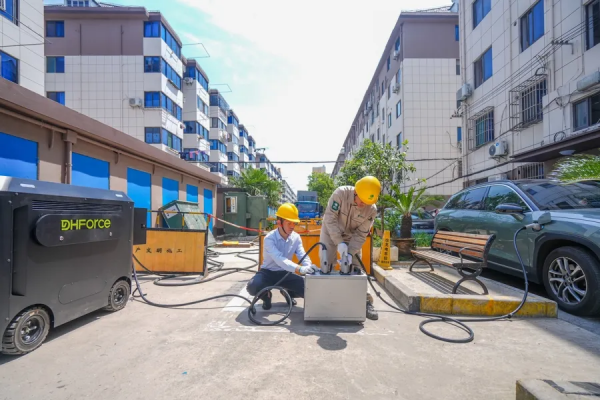
Image/Staff connecting the community to V2G charging piles
Source/Screenshot from New Energy View
As a token of appreciation, the power supply company provided a 1:1.6 electricity subsidy to the car owners who supplied power through the carbon credit system. This meant that for every kWh discharged, they could receive credits worth 1.6 kWh of electricity, which could be directly used to offset cash when charging.
It is precisely by recognizing the social value of reverse discharge that a wave of large-scale adoption has followed. Not long ago, on June 23, 84 charging stations in Shenzhen simultaneously launched reverse discharge demonstrations, covering multiple scenarios such as creative parks, technology enterprises, and 4S stores.
At the F518 Creative Park in Shenzhen, Inflyte intelligently links photovoltaics, energy storage, and V2G: during midday peak electricity prices, the system automatically adjusts the discharge subsidy to 2 yuan/kWh, guiding vehicles to send electricity to the grid. Savvier car owners have mastered "charging arbitrage"—fully charging the battery at 0.4 yuan/kWh in the dead of night and reverse outputting at 4 yuan/kWh at midday, netting 3.6 yuan per kWh.
2. The Technological Confidence of New Energy Marathon Runners
The tremendous driving force brought by the policy engine is also boosting this summer's transformation.
Hangzhou issued Zhejiang's first V2G subsidy policy on July 1. During this year's peak shaving period, charging stations participating in V2G discharge will receive a peak discharge subsidy of up to 2 yuan/kWh.
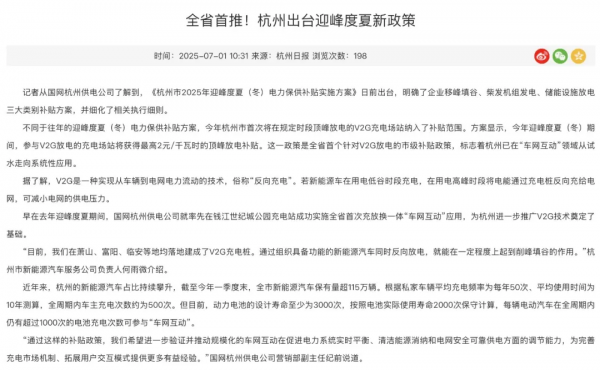
Image/Zhejiang's V2G subsidy policy
Source/Screenshot from New Energy View
But as car owners enjoy the "discharge economy," doubts follow: will frequent charging and discharging drain battery life?
According to Hangzhou's official statement—which issued the subsidy policy—based on an average charging frequency of 50 times per year and an average usage time of 10 years for private vehicles, the total number of charges for car owners within the full cycle is approximately 500 times. However, currently, the design life of power batteries is at least 3000 cycles, and conservatively calculated based on the actual service life of 2000 cycles, each electric vehicle still has over 1000 battery charging cycles available for V2G interaction within the full cycle.
In fact, the claim of 3000 cycles is already outdated. Battery giant CATL's "Sodium New" sodium-ion battery, launched in 2025, pushes the cycle life to over 10,000 cycles, completely rewriting the industry's perception of sodium batteries as "cold-sensitive and short-lived."
Through a composite antifreeze electrolyte and nano-scale electrode design, it maintains 90% of its charge at -40°C and has no power attenuation at 10% low charge. This means that even in Heilongjiang's cold winter, electric vehicles can still stably participate in grid regulation.
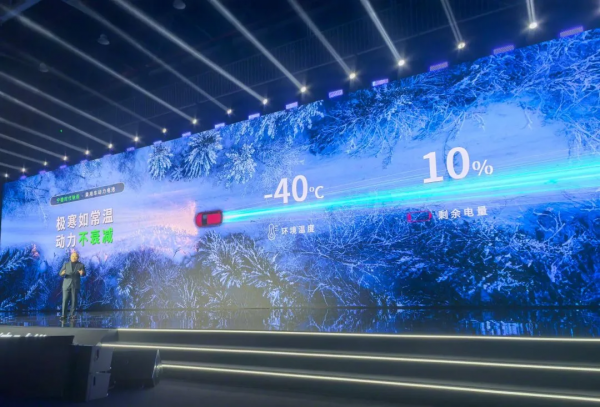
Image/"Sodium New" sodium-ion battery
Source/Screenshot from New Energy View
CATL Chairman Zeng Yuqun has also appealed at multiple automaker launches that car owners can try to fully charge their cars at night and sell the excess during the day when not in use, as it can help them earn money and is a "very interesting thing."
Mr. Wang, a Shenzhen car owner, has personally verified the reliability of the new generation of battery technology. He discharged his battery at the Lianhuashan Supercharger Station for three months, and the battery health still showed 100%. Now, plugging in and discharging during lunch breaks has become a habit, like "saving money" in the grid to collect interest.
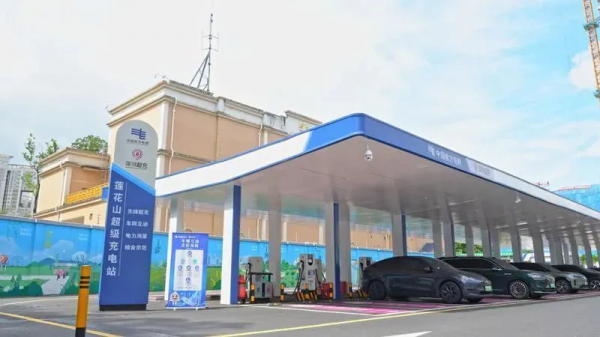
Image/Lianhuashan Supercharger Station
Source/Screenshot from New Energy View
Ultra-long-life battery technology removes concerns about V2G interaction, with the battery functioning like a wallet, where charging and discharging are akin to depositing and withdrawing money. A good wallet can withstand tens of thousands of openings and closings, and now battery giants have created a "titanium alloy wallet."
Additionally, NIO, known as the "infrastructure maniac," has been commended by academicians of the Chinese Academy of Engineering for its over 3,000 battery swap stations. As one-third of China's current electricity already comes from photovoltaics, wind power, and hydropower, the instability of new energy requires energy storage equipment, and batteries have a 100% conversion rate for "peak shaving and valley filling." They store electricity when the grid is abundant, reverse transmit electricity when the grid is tight, and can also swap batteries for vehicles, achieving multiple benefits.
3. A New Energy Ecosystem for a Win-Win-Win Situation
The ripple effects of V2G interaction are spreading from users' wallets to the entire society.
For the grid, pressure is turning into thrust. In China's first batch of nine pilot cities, guiding electric vehicles to transform into "mobile power banks" to feed back into the grid has become an important task for power supply departments this summer.
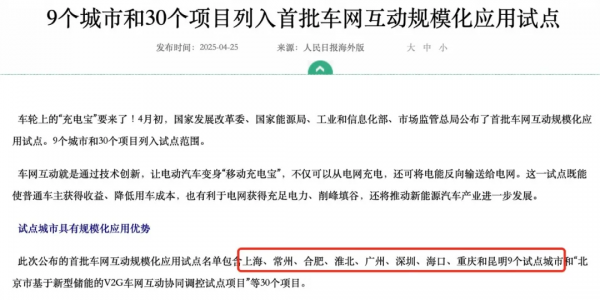
Image/China's first batch of pilot cities
Source/Screenshot from New Energy View
For example, Hangzhou has issued a subsidy policy, hoping to further verify and promote large-scale V2G interaction in enhancing the regulation capabilities of promoting real-time balance of the power system, consumption of clean energy, and safe and reliable power supply of the grid, providing more useful experience for improving the charging market mechanism and expanding user interaction modes.
For users, they used to only care about how fast the charging was, but today car owners are surprised to find that their electric cars can even earn some pocket money and even use their cars at zero cost.
For instance, Mr. Zhang, a freelancer in Shanghai, drives a rear-wheel-drive Tesla Model Y. Because he occasionally needs to travel on business to cities like Hangzhou and Nanjing, even with a home charging pile, he sometimes still needs to charge at outside fast charging piles. The cheapest rate is about seven or eight cents per kWh, and the most expensive he has charged is 2.6 yuan per kWh, so his monthly electricity bill also needs to be around 500 yuan.
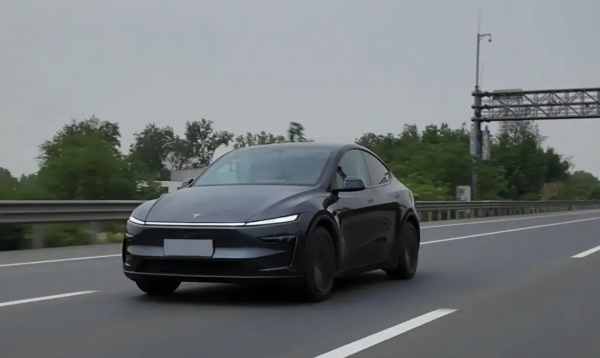
Image/Model Y Rear-Wheel Drive
Source/Screenshot from New Energy View
If he fully charges his battery at the off-peak rate of only three or four cents per kWh when not going out to work and reverses the transmission to the grid during peak electricity usage periods, with a spread of 1 yuan per kWh, then with his 62.5 kWh battery, leaving 20% of the charge for personal use, he can still net 50 yuan each time. This means that he only needs to discharge 10 times a month to use his car at zero cost.
However, such operations are based on the car owner having the time, as currently, the coverage of charging piles that support V2G functionality is low, and car owners need to spend time going to designated charging piles to complete the discharge. With policy advancement and technology popularization, the number of charging piles supporting this function will inevitably increase significantly. Imagine a future where home charging piles can also reverse charge: consumers can plug in the charging pile after returning home from work, set it to reverse charge the grid during peak electricity usage hours, and automatically charge the battery when electricity prices are low in the second half of the night, leaving with a full charge in the morning for work—isn't that both convenient and profitable?
For the entire society, there is a new path for low-carbon transformation. The State Grid transmits hydropower from the southwest and wind and solar power from the northwest through UHV channels, with cross-provincial power transmission exceeding 200 million kilowatts this summer. When clusters of electric vehicles transform into distributed energy storage, the intermittent challenges of wind and solar power are addressed. V2G interaction enhances the resilience of the grid and, more importantly, promotes the consumption of clean energy.
With the implementation of Hangzhou's new subsidy policy of 2 yuan/kWh and the commissioning of CATL's sodium-ion battery mass production line, V2G interaction is transitioning from technological experimentation to large-scale profitability. When tens of millions of electric vehicles are charged and discharged in an orderly manner under grid dispatch, individual benefits and system security have never been so aligned.
At the Shenzhen Bus Group Shenkang Charging Station, more than ten pure electric buses are quietly connected to V2G piles. They collectively discharge during grid peak hours, with each vehicle outputting 150 kWh per discharge, relaying to complete the 15,000 kWh daily discharge target. These once purely power-consuming steel bodies are now reconstructing energy logic with the "discharge economy."
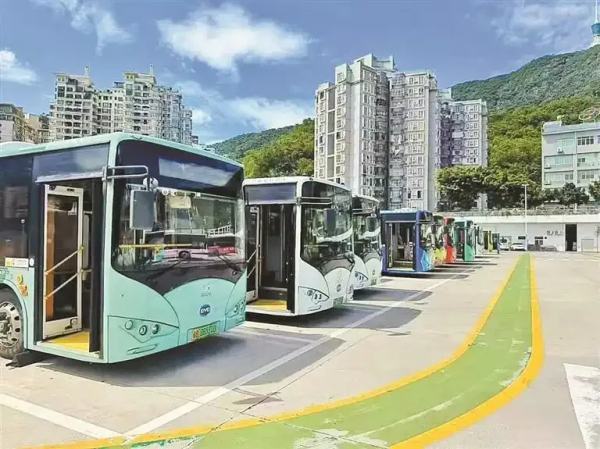
Image/Shenzhen Bus Group Shenkang Charging Station V2G Reverse Power Supply
Source/Screenshot from New Energy View
At the outset, Chengdu car owner Zhu Liang aptly stated, "Parking and charging an electric vehicle is akin to opening a bank account, where you deposit electricity and withdraw 'money' as needed." This subtle energy revolution is transforming each electric car into a vital capillary of the smart grid, scripting a novel narrative for profit-making amidst the tide of carbon neutrality, leveraging the dynamic of "buying low and selling high" in the energy market.







